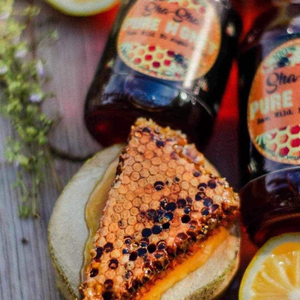Search
₱190.00
PURE RAW WILD HONEY 100% 500ml Unprocessed/ Unadulterated harvested from Mt Banahaw by Sha-sha's Pure Honey
Sold by Sha-sha's Pure Raw Wild Honey
4.3(4)
9 sold
Select options
Select
Shipping
From ₱80.00
Est. delivery by Apr 21 - Apr 25
Specifications
Customer reviews (4)
I**R
Item: 500ml
I bought this honey panghalo sa salabat with lemon..I used to buy honey, fresh from the mountainous part of Albay and tastes good.This honey has a different taste maybe because from Mt Banahaw pa. Anyway, gusto ko lng siya i-try if I could find honey online gaya ng hinahanap ko.


1d ago

J**y N**o
Item: 500ml
Pure, tried and tested.
January 10, 2025

C**o
Item: 500ml
mukhang di puro.... kasi amoy arnibal
May 21, 2024

Sha-sha's Pure Raw Wild Honey
6 items
About this product
FDA Registration No.LTO-3000007293046
OrganicYes
Age WarningYes
Quantity Per Pack1
IngredientsHoney
Country of OriginPhilippines
Product description
SHA-SHA's PURE RAW WILD HONEY is sourced from the untouched wilderness of Mount Banahaw, where bees roam freely amidst lush flora, creating a honey that captures the essence of the wild. This honey is unfiltered and unpasteurized, retaining all its natural enzymes, antioxidants, and nutrients.
Some BENEFITS OF HONEY include:
●Nutritional Value: Honey is rich in antioxidants, vitamins, and minerals, including vitamin C, calcium, and iron. It provides a natural source of energy due to its high carbohydrate content.
●Antimicrobial Properties: Honey has natural antimicrobial properties, making it effective in treating wounds and preventing infections. It has been used traditionally as a topical treatment for burns, cuts, and scrapes.
●Cough Relief: Honey is often used as a home remedy for soothing coughs and sore throats. Its thick consistency helps coat the throat, while its antimicrobial properties may help fight off infection.
●Digestive Health: Consuming honey in moderation may promote digestive health. It can help soothe the digestive tract and alleviate symptoms of indigestion or constipation.
●Allergy Relief: Some people believe that consuming locally sourced honey can help alleviate seasonal allergies. The theory is that trace amounts of pollen in the honey may help desensitize the immune system.
●Skin Care: Honey is sometimes used in skincare products for its moisturizing and antibacterial properties. It can help hydrate the skin and promote healing in minor wounds or acne.ï.
Overall, honey is a versatile natural ingredient with numerous health benefits. However, it's essential to use it in moderation due to its high sugar content.

Here's how to test if your honey is PURE:
●Water Test:
Start with the water test – a straightforward method to assess the purity of honey. Take a tablespoon of honey and mix it in a glass of water. If the honey is pure, it will lump together and settle at the bottom without readily dissolving. On the other hand, if it dissolves easily and blends uniformly with the water, it may indicate adulteration, possibly containing added moisture or syrups.
●Paper Towel Test:
The paper towel test is another easy method. Place a small drop of honey onto a sheet of paper towel. Pure honey will not leave a noticeable wet mark and won't be absorbed rapidly. If the honey is absorbed swiftly, it might be indicative of adulteration, possibly containing added water or other substances.
●Heat Test:
The heat test involves gently heating a small quantity of honey. Pure honey will caramelize, taking on a golden hue and releasing a delightful aroma. Impure or adulterated honey, on the other hand, may burn or emit a burnt odor when heated.
●Examine the Color:
The color of honey can be a reliable indicator. Pure honey typically exhibits a rich golden or amber hue, varying slightly based on the nectar source. If your honey appears overly clear or has a very light color, it might be a sign of dilution with water or the addition of sweeteners.
●Look for Crystallization: Crystallization is a natural process in honey, transforming it from liquid to a thicker form over time. This natural occurrence confirms the authenticity of honey. However, if your honey never crystallizes and remains in a liquid state indefinitely, it may suggest excessive heating or processing during production, indicating potential adulteration.
●Vinegar Test:
Testing honey with vinegar is a simple method. Pure honey, being naturally acidic, won't readily react with vinegar. If foaming occurs when honey and vinegar are mixed, it suggests impurities, possibly added water or sugar.
Reminder: The honey that we harvest will be in different colors/flavors in different seasons, based on what plants or flowers are in bloom and when.
Ingredient: Honey
Size: 1 Litre/750ml/500ml/350ml/250ml
Warning: Raw honey is not recommended below 1 year old.




Explore more from Sha-sha's Pure Raw Wild Honey





















No more products
Open TikTok





















